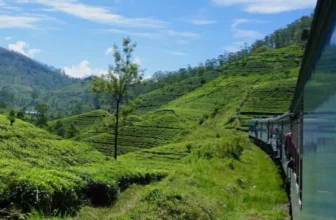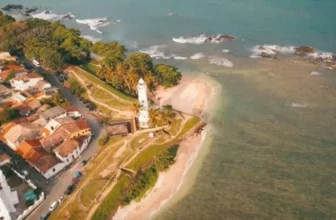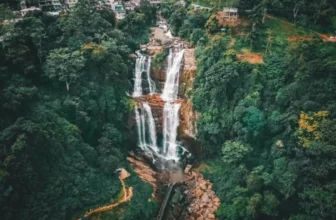Yesterday I visited Pinnawala Elephant Orphanage as part of my organized tour of Sri Lanka. It was a last-minute addition to our itinerary and I was actually slightly terrified of visiting as had read so many negative blog posts from some of the world’s top bloggers, all telling people to avoid this apparently “cruel” place. I decided I needed to see it with my own eyes, interview some staff there and make a balanced decision based on their knowledge and of course what I saw throughout the morning. I quickly discovered that many bloggers were so fast to come to a conclusion about this place that they didn’t bother to really understand what the centre is trying to achieve, or to listen to the answers to their questions.
READ NEXT: Where to go on a wild elephant safari in Sri Lanka
Yes, there are problems that need addressing, which I’ll cover later, but they are NOT the problems you think they are.
The one thing this visit taught me the most was the true power of travel bloggers and influencers. A few select bloggers have severely negatively impacted this elephant sanctuary, with some international tour companies even deciding to cross Pinnawala off their list of must-visit places in Sri Lanka.
Were these harsh and damning opinions and blog posts true? Did the bloggers with such strong opinions ask the right questions to staff members? More importantly, did they even wait to listen to the answers. I’m not going to tell whether it’s right to visit or not, that’s a decision for you to make, but I am going to present the facts and what my general impression of Pinnawala Elephant Orphanage is now that I have visited myself.
READ: World Elephant Day: How to help elephants while you travel
This IS a conservation project
I strongly believe Pinnawala Elephant Orphanage should be viewed as a conservation project, as their aim at the end of the day is to protect Sri Lankan elephants, a species that are considered endangered and at risk of becoming extinct.
With the rise of social media and how fast people make travel decisions after reading something online or watching a viral video, it is more important than ever for Pinnawala to address problems and find solutions for issues that tourists may have when visiting.
Why does Pinnawala rely so heavily on tourists? The orphanage cares for almost 80 elephants. Each of these elephants eats over 100 – 150KG of food a day and 40 litres of water. The baby elephants need to be fed milk 5 times a day! That is a LOT of milk and insane amount of food – mainly consisting of grass, leaves and plants. Can you imagine how much money it costs to run a place like this? Tourist dollars are important to help pay for this massive daily food bill, and to pay for staff to work with and care for the elephants.
And yes, they really, really do care for and love these elephants. Just listening to them talk about the elephants in their care, how they truly understand these incredible animals and know their needs, made me realise just how much they want to protect them.
FACT: The Sri Lankan Elephant is considered to be an animal that is in immediate danger of becoming extinct as populations have been declining at a critical rate. Pinnawala Elephant Orphanage is helping to stop this rapid level of decline by saving as many elephants as possible. Their facility, as 26.5 acres, will soon be too small to cater to so many grown elephants. When this happens they will either expand or open up a second orphanage nearby.
FACT: Pinnawala Elephant Orphanage DOES NOT ALLOW tourists to ride elephants. I was worried because I saw photos on Instagram tagged at the sanctuary but it turned out that is a private operator, that privately owns some elephants, operating in the same town. NOTE: Both keeping your own elephant and elephant rides are not illiegal in Sri Lanka. Yet.

Pinnawala Elephant Orphanage – Your Questions Answered
Why do the large elephants look distressed?
In many of the blog posts I read that told people NOT to visit Pinnawala, they talked about the elephants looking like they were very distressed, shaking their heads up and down and flapping their ears. I wondered the same myself, until the curator of Pinnawala explained it to me.
Male elephants go through what is called a “musth period” for between 1 and 5 months each year. This is when they produce 60 times more testosterone than normal! The very high levels of testosterone mean that the elephant has a lot of extra energy, is often agitated and can get aggressive. Even the most placid and seemingly calm elephants can get very violent towards humans and other elephants during this period.
In the wild, they start fighting other adult elephants and often kill them. This actually happened just a few weeks ago in another part of Sr Lanka, where a male elephant killed another in Yala National Park. So in other words, yes the elephants do look distressed, but no more so than when they are in the wild.
In Africa, there have been cases of rogue wild elephants during the musth period attacking native villages and also attacking and killing other animals such as rhinoceroses without provocation.


This male elephant was quite distressed an at first I was worried. The curator explained that it is in musth period, with 60 times as much testosterone as usual. This is why for a few months every year, all large males are kept separate from the herd.
Why are some elephants chained?
Some of the larger elephants are chained for three reasons.
1. The elephant is new to the orphanage and must be trained.
Most of the elephants in the orphanage are baby elephants that have been abandoned by the herd. However, Pinnawala also takes in old, injured and abused elephants. If an adult elephant is injured or becomes blind, they take it in to care for it. They also sometimes take in elephants that were previously illegally owned by private people in Sri Lanka. It is illegal in some cases to keep an elephant at your private residence so when someone is exposed, Pinnawala adopt the elephant and often nurse it back to good health. These elephants are used to being on their own, so when put in with large herd of 60 strange elephants it can become agitated and aggressive. They are chained when with the herd (such as bathing time) to stop them injuring anyone else.
If you do let these elephants back into the wild, having lived with humans for most of their life and been fed each day by humans, they will go straight to the nearest human settlement looking for food and will either injure people or injure itself.
2. The male elephant is in a Musth Period (READ: horny as hell)
As explained about the distressed looking elephants, male elephants need to be chained up for between 1 and 5 months a year to protect others and protect themselves. Yes, that does seem like a very long time, but what other options are there? They can and do kill each other during this period.
3. To control the head female elephant
When they bring the herd down to be bathed, you will notice that the Queen Bee of the herd, the head female elephant, is chained to the river bed. This is because the entire herd follow what the female does, so if she makes a run for it and plans to stamp on a nearby crowd of tourists, you can be sure the entire herd will follow. if she goes into the very deep water, the entire herd will follow. And the baby elephants sometimes drown when this happens, as was the case with one baby ele in Pinnawala back in 2011.

The large herd of elephants during bath time at Pinnawala
Aren’t the chains sore?
According to the curator, the chains are actually not sore. Considering the size of these elephants, the chains do not feel heavy and do not cause pain. It would be similar to us wearing a light, gold chain. it does not feel heavy.
Is there no alternative to chains?
They have tried some alternatives, like rope or cloth, but they caused the elephants more harm than good. When wet that rub off the skin of the elephants feet, and unlike chains, there is no air circulation holes so altogether it is not a comfortable experience for the elephants.
Why do the Mahouts use bull hooks?
First of all, bull hooks REALLY aren’t as scary as they look. We got to hold one and the pointy bit is not actually pointy at all, but rounded at the end. This is used to push certain pressure points on the elephant’s body, to help control them. It is not to harm them or hurt them, but to help direct them to walk in a certain direction or to help when bathing them.


Should all elephants not just be LEFT in the wild?
The fact remains, would all the elephants, be it abandoned babies, injured adults and abused and rescued elephants from temples or private homes not just be better off in the wild? Let nature do its thing!
They say out of the 80 elephants in the orphanage, maybe about 20 would have made it in the wild and survived, if left there. The other 60 would not be here today, either unable to fend for themselves, unable to find food or killed by one of the stronger elephants or a predator. So which is better? You can have 80 live elephants help in a sanctuary, where they are cared for, fed 5 times a day and have 26.5 acres to wander. Or you can have just 1/4 of that elephant population in the wild, probably much happier, roaming free. I don’t know the answer, but it’s an interesting question. Also, thanks to their large size, elephants are top of the food chain in Sri Lanka bar one fast and hungry animal – the tiger! Tigers generally stay away from adult elephants but often target baby elephants, especially those abandoned by the herd.
Why do the mahouts ride the elephants?
I think at this stage everyone and their aunt knows that it’s bad to ride elephants. There have been so many awareness campaigns, blog posts and articles written and videos shared, that is is a dying tourist activity and one no self-respecting blogger or travel influencer would go near. That said, loud and clear, riding elephants doesn’t always have to mean the worst. Sri Lanka have been working with elephants for thousands of years, and do this day mahouts and the training of elephants is still seen as an ancient skill. Mahouts train elephants in many ways, and one way is for them to bond with he elephant and for the elephant to feel their presence. In order to this, they say sitting on the elephant brings them closer and makes the elephant react better to what the mahout wants it to do. I believe, as with everything, there is often more to what we see than first meets the eye.
What needs to be fixed?
I think the main problem with Pinnawala is the lack of education about what the centre is doing, and why they do what they do. This lack of information is leading to people leaving the elephant orphanage unsure of what they have seen and often with negative feelings. Information boards are needed to educate visitors and guides are needed to give talks to groups, explain why certain elephants are tied up and separated from the herd, why they can’t be released back into the wild. To talk about the injured animals and what the centre is doing to help them, and probably much much more.


Should you visit?
That’s up to you. Just do us all a favour and read both sides of the story before you decide to visit. If you want to help a great conservation project, aimed at rescuing and caring for elephants, then I believe Pinnawala Elephant Orphanage is a great place to visit. Be sure to find some staff and ask lots of questions, they will answer you as best they can.
If you are against going to a zoo, going to a wildlife park or any sort of centre that takes wild animals away from their natural habitat, then it’s probably best not to visit. You can go on an elephant safari in many places in Sri Lanka, such as Yala National Park or Habarana, and see these beauties in the wild.









